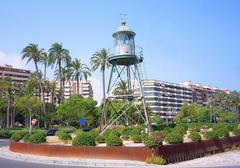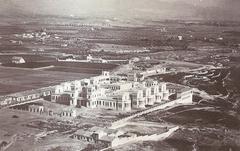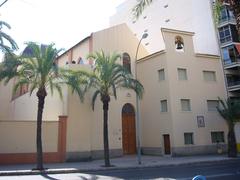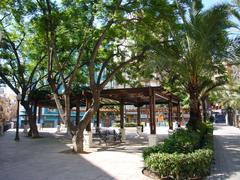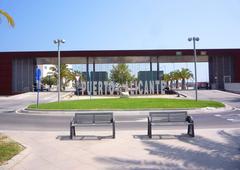Torre Boter Alicante: Visiting Hours, Tickets, and Historical Sites Guide
Date: 14/06/2025
Introduction
Torre Boter rises from the fertile plains of the Huerta de Alicante, embodying centuries of rural heritage and defensive ingenuity. As one of the renowned “Torres de la Huerta,” this historic watchtower was built between the 16th and 18th centuries to safeguard local communities from Mediterranean pirate raids. Today, Torre Boter stands as a silent witness to Alicante’s layered past, offering visitors a unique glimpse into the intersection of agriculture, architecture, and regional security (spaincycletouring.com; alicanteturismo.com).
This comprehensive guide provides everything you need to know for planning a visit: historical context, architectural features, visiting hours, ticketing policies, accessibility tips, and practical travel advice. Whether you’re a history enthusiast, cyclist, or cultural traveler, Torre Boter offers an evocative waypoint on Alicante’s heritage trails.
Table of Contents
- Origins and Historical Context
- Architectural Features and Defensive Function
- Socio-Economic Significance
- Preservation and Current Status
- Visiting Torre Boter: Hours, Tickets, and Accessibility
- Visitor Experience and Practical Information
- Nearby Attractions and Suggested Itineraries
- Cultural Etiquette and Sustainability
- Frequently Asked Questions (FAQ)
- References and Official Sources
Origins and Historical Context
Torre Boter is a prominent member of the “Torres de la Huerta” network—fortified rural towers spread across the agricultural belt northeast of Alicante. These towers, built mainly in the 16th and 17th centuries, were a direct response to the threat of Berber pirate raids that plagued the Spanish Mediterranean coast. Local landowners constructed them as both lookout points and refuges, enabling communities to protect their families and agricultural wealth in times of danger (spaincycletouring.com).
The Huerta de Alicante, irrigated by acequias (water channels) from the Montnegre river, was the economic heart of the region, making its protection critical. Torre Boter, strategically located along the historic Camí de Benimagrell, played a vital role in this defensive network, relaying signals to neighboring towers and settlements.
Architectural Features and Defensive Function
Torre Boter epitomizes the robust, utilitarian architecture of the Torres de la Huerta. The tower is typically two to three stories high, with thick limestone and sandstone masonry walls over a meter wide at the base. Defensive features include narrow slit windows for surveillance, limited ground-floor openings, and an elevated entrance accessible only by ladder or removable staircase—designs intended to delay or deter attackers.
The tower’s upper floors once provided living quarters and storage, while the roof or parapet offered panoramic views over the huerta and coastline. Occasional decorative elements, such as carved lintels, reflect the social status of its owners, though the primary focus remained on function and security (Plinthus).
Socio-Economic Significance
Beyond their defensive purpose, towers like Torre Boter played a pivotal role in the socio-economic structure of the huerta. They allowed agricultural estates to flourish by ensuring a degree of safety for farmers and their produce. The towers became enduring symbols of local prosperity and resilience. As rural life evolved and urban expansion encroached, the economic centrality of the huerta waned, but these towers remain powerful markers of a time when defense and cultivation were intimately linked (spaincycletouring.com).
Preservation and Current Status
Torre Boter is preserved as a “Bien de Relevancia Local” (Asset of Local Relevance), offering it legal protection and highlighting its historical value. Its private ownership has limited restoration efforts and public access, leaving the tower structurally intact but vulnerable to weathering and neglect. Ongoing challenges include urban development pressure and environmental wear, making community advocacy and heritage initiatives essential for its long-term survival (Plinthus).
Visiting Torre Boter: Hours, Tickets, and Accessibility
Location and Access
- Address: Camino de Benimagrell, 33, San Juan de Alicante (north of Alicante city)
- Transport: Easily reached by car, bicycle, or public transport. The Alicante tram system connects the city with San Juan and nearby towns (Turispanish).
- Parking: Limited spaces along the Camino de Benimagrell.
Visiting Hours and Tickets
- Opening Hours: The tower is privately owned and inhabited; there are no official opening hours for interior visits.
- Exterior Viewing: Visitors may observe and photograph Torre Boter from public roads or designated viewpoints at any time.
- Tickets: No entrance fee or tickets are required for exterior viewing (CastillosRicsol).
Accessibility
- Terrain: Flat but may be uneven or unpaved; suitable for most walkers and cyclists, but challenging for those with limited mobility.
- Facilities: No restrooms or refreshments on site; nearest amenities are in San Juan de Alicante (about 2 km away).
Visitor Experience and Practical Information
What to Bring
- Comfortable walking or cycling shoes
- Water and snacks
- Sun protection (hat, sunscreen)
- Camera
- Map or GPS for cycling/walking routes
Best Time to Visit
- Spring and Autumn: Pleasant temperatures and vibrant scenery
- Summer: Possible but can be hot (above 30°C); visit early morning or late afternoon for comfort and best light
Photography
- Excellent exterior photo opportunities, especially in the golden hours.
- Use discretion and avoid drone use due to privacy and local regulations.
Guided Tours and Interpretation
- While the interior is not open, Torre Boter features in several local heritage and cycling routes.
- Interpretive panels and downloadable guides are available for the broader Torres de la Huerta network (Alicante Top Sightseeing).
- Local historical associations and private guides offer multi-tower tours with in-depth context.
Nearby Attractions and Suggested Itineraries
- Other Torres de la Huerta: Explore a network of over 20 towers, each with distinct features (View from La Vila).
- Santa Faz Monastery: Major pilgrimage site nearby.
- Alicante City Center: Home to Santa Bárbara Castle, Explanada de España, and vibrant markets (Turispanish).
- Beaches: Playa de San Juan and Playa del Postiguet are easily accessed for relaxation.
Suggested half-day itinerary: Morning cycle/drive through the huerta with stops at several towers, lunch in San Juan de Alicante, and an afternoon at the beach or city center.
Cultural Etiquette and Sustainability
- Respect Private Property: Do not enter the tower or disturb residents.
- Support Local Economy: Purchase local products or dine nearby to help preserve the region’s heritage.
- Preserve the Environment: Stick to marked paths, leave no waste, and avoid disturbing crops or wildlife.
- Participate in Local Culture: Attend festivals (e.g., Hogueras de San Juan) for a deeper cultural experience (AllEvents Alicante).
Frequently Asked Questions (FAQ)
Q: What are Torre Boter’s visiting hours?
A: The tower is not open for interior visits, but its exterior can be viewed anytime from public areas.
Q: Is there an entrance fee or are tickets required?
A: No fee or tickets are required for exterior viewing.
Q: How do I reach Torre Boter from Alicante city center?
A: By car, bicycle, or the Alicante tram to San Juan, followed by a short walk or cycle.
Q: Are guided tours available?
A: No interior tours, but local associations offer tours of the broader Torres de la Huerta.
Q: Is the site accessible for visitors with limited mobility?
A: Terrain may be uneven; for accessibility needs, consider city center attractions (TravelTomTom).
References and Official Sources
- spaincycletouring.com
- Plinthus
- alicanteturismo.com
- CastillosRicsol
- Alicante Ayuntamiento (official municipal guide)
- Alicante Top Sightseeing
- Turispanish
- View from La Vila
- Guía Castillos Alicante
- AllEvents Alicante
- TravelTomTom
Summary
Torre Boter offers a compelling window into Alicante’s agricultural and defensive history. While its interior remains private, the tower’s enduring exterior and scenic rural setting make it a rewarding stop for culturally curious visitors. Embrace respectful travel, explore the broader network of Torres de la Huerta, and support local heritage initiatives to help preserve this unique cultural landscape for future generations.
For interactive maps, guided experiences, and further travel inspiration, download the Audiala app and connect with our community on social media.

